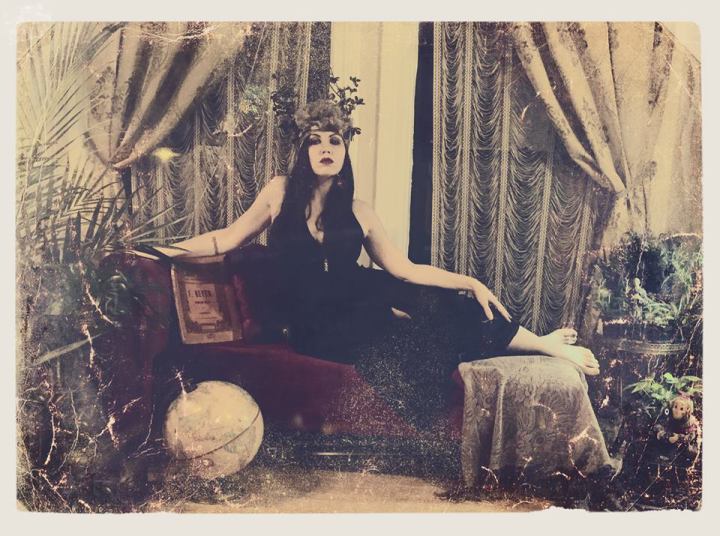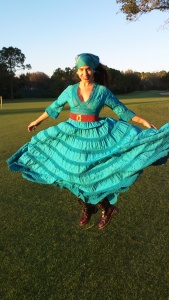I already loved this Wolfwych interview with Katelan Foisy before I noticed that she very kindly listed this blog as a reference for Romani folklore and culture. Foisy is an artist, witch, writer, model, fortune teller… she does all of it, and lives her life with an admirable sense of purpose and ritual. She’s also of Sinti heritage, like me, and one of the most delightful and generous people I’ve ever met. During the Romani Arts and Letters Conference at NYU, I gave a talk on the importance of her work and the work of Selma Selman in reconfiguring the archetype of the “Gypsy Woman,” and included the PowerPoint here: Portraits and Performativity. If you would like to read a thoughtful and beautifully crafted interview with her about her artwork, life, magical work, fortune telling, and reading list, then here you go, and you’re welcome. Enjoy! https://wolfwych.com/2017/07/20/mystic-lady-an-interview-with-katelan-foisy/
I’ve gotten some of my best divination from cut-ups and some very good practical advice. It rearranges the brain to see what isn’t there. I’m also a fan of working with technology to increase energy. We are creating magical worlds with our internet presences so when I’m doing a working, I will photograph parts of it, edit the image to enhance the feeling of the work and put it up online. I feel that the love and buoyancy that pours in from that helps to boost the energy within the working. It’s one of the reasons I take so much care in the aesthetics of the working. If each working itself is it’s one piece of art, the care put into each work becomes part of the magic in that particular working. This method is what works best for me but each practitioner will have their own method. For instance I work with land magic a lot. If I’m doing a working for immigration I will take that person with me on a journey and the we will walk the path of those that came before us. I believe we need to know the history of the land before we can work our magic there. That may be one thing that I find odd about some modern day practices and with people in general. We tend to forget our history but the real magic lies underneath the pavement and deep within the soil, it lies in land memory. –Excerpt from interview
Image by Katelan Foisy, featured in WolfWych









 January 27th, 2016 is International Holocaust Remembrance Day. We spread red flowers to honor those who lived and died in what Roma call, The Hungry Smoke. The Holocaust was an ugly genocide of those from the Jewish faith as well as those who were ethnically “Gypsies,” the racial slur used to describe Romani and Sinti people. The Sinti are a clan (or tribe, as some prefer that word while others argue that ours is not a tribal society) within the Roma, and the word Roma refers to the many different cultures and subcultures that exist within Romani society, all of which are distinct with their own dialects, customs, and beliefs. Many Sinti prefer to be called Sinti and not to be included under the Romani umbrella, but I am comfortable being referred to as Romani, both because my heritage is very ethnically mixed anyway and because I like the inclusiveness that the word “Roma” suggests. My grandmother and many of her family members survived O Porrajmos, or the Great Devouring, by hiding their ethnicity, something that many were not able to do, and others among her friends and family were not so fortunate. The Roma and Sinti are often forgotten alongside the other groups targeted, such as LGBTQ* people, people living with disabilities, Catholics, Communists, and many others. Even though half of the Romani population was obliterated during WWII, because of
January 27th, 2016 is International Holocaust Remembrance Day. We spread red flowers to honor those who lived and died in what Roma call, The Hungry Smoke. The Holocaust was an ugly genocide of those from the Jewish faith as well as those who were ethnically “Gypsies,” the racial slur used to describe Romani and Sinti people. The Sinti are a clan (or tribe, as some prefer that word while others argue that ours is not a tribal society) within the Roma, and the word Roma refers to the many different cultures and subcultures that exist within Romani society, all of which are distinct with their own dialects, customs, and beliefs. Many Sinti prefer to be called Sinti and not to be included under the Romani umbrella, but I am comfortable being referred to as Romani, both because my heritage is very ethnically mixed anyway and because I like the inclusiveness that the word “Roma” suggests. My grandmother and many of her family members survived O Porrajmos, or the Great Devouring, by hiding their ethnicity, something that many were not able to do, and others among her friends and family were not so fortunate. The Roma and Sinti are often forgotten alongside the other groups targeted, such as LGBTQ* people, people living with disabilities, Catholics, Communists, and many others. Even though half of the Romani population was obliterated during WWII, because of 







